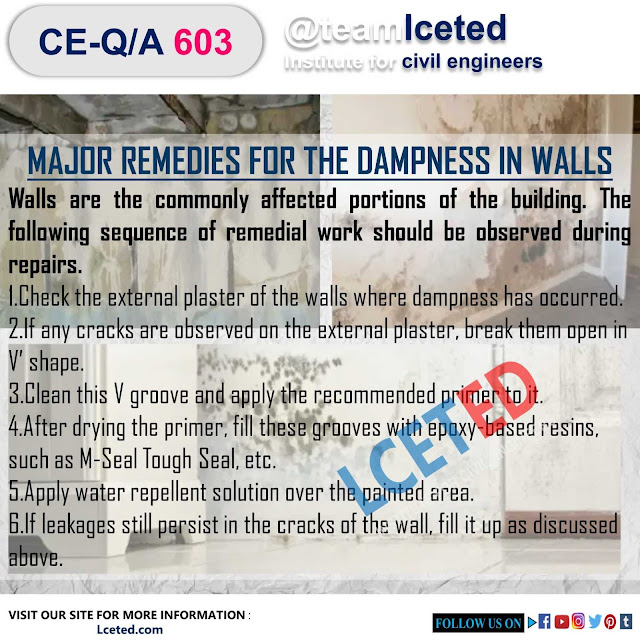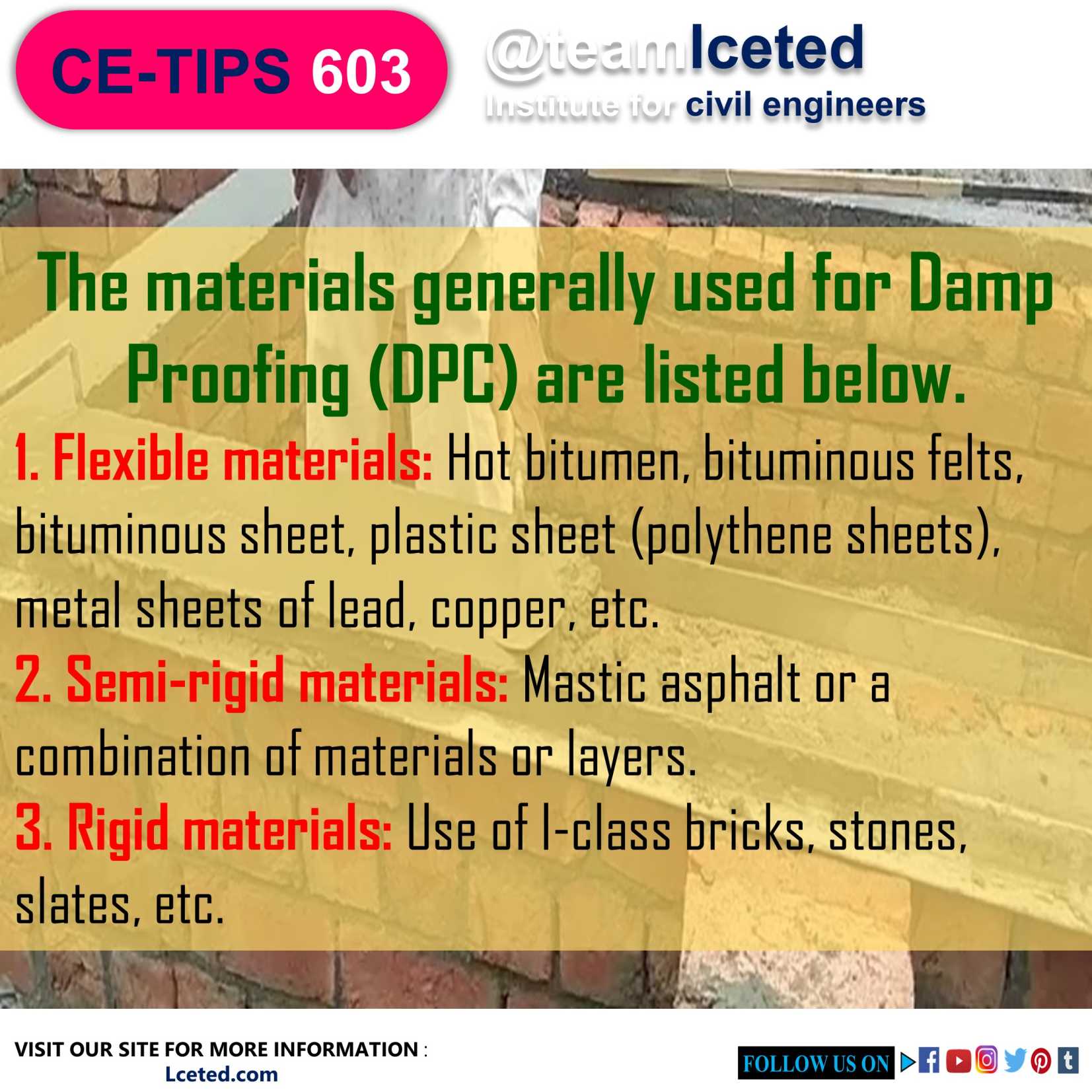MATERIALS USED FOR DAMP PROOFING (DPC)
There are various materials, which are used as damp-proof
courses depending upon the location, economy and degree of damp proofing desired.
However, while selecting a particular damp-proofing material, the following
requirements of an ideal damp-proofing material should be remembered.
1. The
material for DPC should be impervious and durable, i.e., the material should be
effective during the useful life of the building.
2. The material should be capable of resisting both dead loads and superimposed loads without being disintegrated.
3. The
material should remain steady in its position, without any movements, so that
the walls overlying the DPC do not develop any cracks.
4. For
DPC above the ground level, with wall thickness up to 40 cm, any material
listed below for DPC can be used.
5. For
DPC to be laid over larger areas, such as floors and roofs, and thicker walls, a
DPC material that provides a lesser number of joints should be used, such as
mastic asphalt, bitumen sheeting and plastic sheeting.
6. The
material for parapet walls and in other situations where differential thermal
movements are expected due to exposure should be of flexible material, like
mastic asphalt, bituminous felt and metal sheets.
7. In
water-retaining structures or situations, a jointless DPC should be provided to
take care of the risk of leakage.
8. In the cavity or hollow walls, the cavity over the door or window openings should be
bridged by flexible materials, like bitumen sheets, strips of lead and copper.
The
materials generally used for DPC are listed below.
1. Flexible
materials: Hot bitumen, bituminous felts, bituminous sheet, plastic
sheet (polythene sheets), metal sheets of lead, copper, etc.
2. Semi-rigid
materials: Mastic asphalt or a combination of materials or layers.
3. Rigid
materials: Use of I-class bricks, stones, slates, etc.
Hot bitumen or hot asphalt
This is a flexible material, which is first heated and then
spread over the bedding of concrete or mortar (i.e., over walls). This should
not be applied in thickness less than 3 mm. Bitumen or asphalt forms an
excellent damp-proof course, as it offers an impervious, indestructible and
tough surface.
Bituminous felts (6 mm thick sheet or asphaltic felt)
This is also a flexible
material, which is available in rolls of normal wall widths. For placing this
in position, first a layer of cement mortar is laid on the brickwork and then
DPC is bedded on it. An overlap of 10 cm in case of joints and full-width
overlap in case of angles and crossings should be provided. Bitumen felt is
capable of accommodating slight movements but cannot withstand heavy loads.
Sheets of lead, copper and aluminium (metal sheets)
These are used as membranes for damp proofing and are of
flexible type.
Sheets of lead
The thickness of the sheet should
be such that the weight of the sheet is not less than 20 kg/m2. These are spread on
the walls and overlapped at the joints. The sheets of lead should be embedded
in lime mortar and not in cement mortar (because cement chemically reacts with
lead and destroys it). The surfaces of lead should be protected by a coating of
bitumen against corrosion. DPC formed by lead sheet provides an impervious and
highly resistant surface against lateral movements.
Sheets of copper (minimum 3 mm thick)
Like lead sheets, these are
spread, lapped and jointed. They are embedded in lime or cement mortar. This is
another excellent DPC material that possesses characteristics such as high
durability, good resistance to dampness and high resistance against sliding
action.
Sheets of aluminium
These can also be used for DPC but not as good as to lead or
copper sheets. These sheets should be protected with a layer of bitumen.
Combination of sheets and bituminous felts
A lead foil is sandwiched between the sheets of asphalt or
bituminous felt. This combined sheet is known as ‘lead core’ and DPC of this
core possesses the characteristics of easy laying, durability, efficiency and
economy.
Mastic asphalt
This is obtained by heating the asphalt with sand and
mineral fillers. This is a semi-rigid material and forms an excellent impervious
layer for damp proofing, i.e., DPC. However, it requires special care in its
laying. Good mastic asphalt has many characteristics, such as high durability,
excellent water-proofing quality and reasonable elasticity. This can withstand
only very slight distortion and is liable to lateral movements under heavy
pressures or very hot climates.
ALSO READ: Damp Proofing | Sources Of Dampness | Effects Of Dampness | Techniques And Methods | Uses
Bricks
Good dense bricks, which absorb water less than 4 per cent
of their weight, are suitable as a DPC material at places where the damp is not
excessive. The joints are left open. They are widely used for providing or
inserting a DPC membrane in an existing wall.
Stones
Generally, dense and sound stones, such as granite, trap
and slates, are laid in cement mortar in two courses to form an effective DPC.
The stones are used for the full width of the wall. While laying the stones,
care should be taken in breaking the continuity of vertical joints.
Cement concrete layers
A cement concrete layer,
having mixed proportions 1:2:4 (1 cement:2 sand:4 aggregates) with waterproofing
agents, is used as DPC at the plinth level. It is effective in stopping the
water rising due to capillary action but allows the water to pass through the
cracks, etc., and hence is suitable as DPC material where dampness is not in
excess. The concrete layer is used as a horizontal main DPC in thickness varying
from 4 to 15 cm followed by two coats of hot bitumen paint.
Mortar
It is used in two ways, either
(i) as a bedding layer for taking up other types of DPC or (ii) as a
waterproofing plaster. For the bedding layer, the mortar is prepared by mixing
cement and sand in proportions 1:3 and adding slight lime to increase the
workability. For waterproofing plasterwork, the mortar is prepared by mixing
either of the following:
a. 1 cement:2 sand pulverized alum and
soap water,
b. Cement: sand in proportions 1:3, with patented waterproofing
material like pudio, dampro and sika. After applying this plaster in 2–4 cm
thickness, it is painted with two coats of hot bitumen.
If you find
This information helpful, please share it.
Thanks! For reading the article.









No comments:
Post a Comment